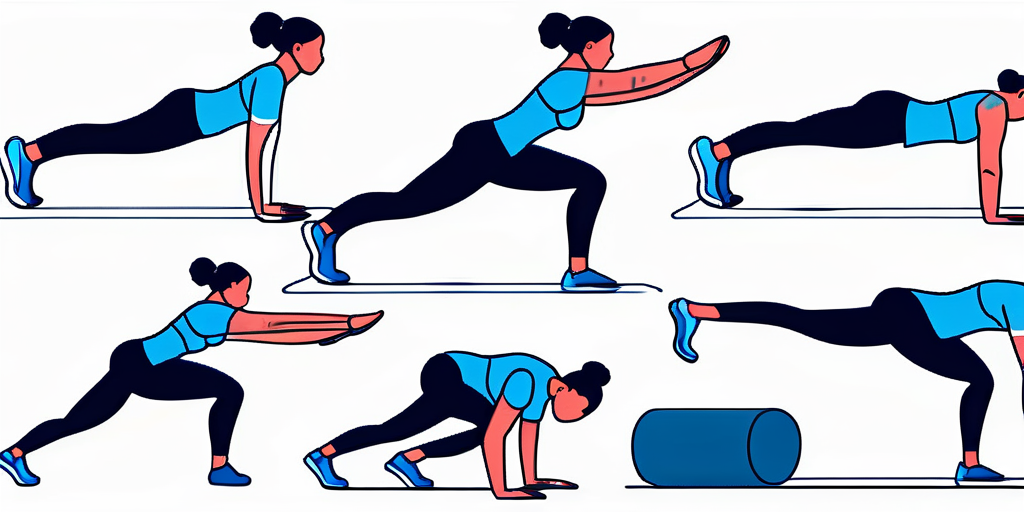Many athletes focus primarily on strength training and conditioning in the pursuit of peak athletic performance. While these aspects are undeniably crucial, one often overlooked component is mobility work. Incorporating mobility exercises into an athlete’s routine can have a profound impact on their overall performance and reduce the risk of injuries. Let’s delve into the importance of mobility work and explore how it can benefit athletes of all levels.
Understanding Mobility and Its Role in Athletic Performance
Before dissecting the significance of mobility work, it’s essential to understand what mobility is and how it pertains to athletic performance. In simple terms, mobility refers to the ability to move freely and easily through a complete range of motion. It encompasses flexibility, stability, and joint mobility. Athletes who possess good mobility can execute movements with precision, efficiency, and power.

When athletes lack mobility, their performance is often compromised. Limited mobility restricts movement patterns, leading to inefficient and biomechanically compromised techniques. Consequently, this can hamper an athlete’s ability to generate power, maintain balance, and execute skills effectively. Moreover, poor mobility can increase the risk of overuse injuries, muscular imbalances, and decreased athletic performance.
One key aspect of mobility training is the focus on dynamic stretching exercises. Dynamic stretching involves moving parts of your body and gradually increasing reach, speed of movement, or both. This type of stretching helps improve joint flexibility, muscle activation, and overall body awareness. By incorporating dynamic stretching into a warm-up routine, athletes can prepare their bodies for the specific movements required during training or competition.
Another important component of enhancing mobility is proprioceptive neuromuscular facilitation (PNF) stretching. PNF stretching techniques involve a combination of stretching and contracting of targeted muscle groups. This method helps improve flexibility and strength simultaneously, making it an effective tool for athletes looking to enhance their performance. By engaging in regular PNF stretching sessions, athletes can increase their range of motion, improve muscle coordination, and reduce the risk of injuries related to tight muscles or restricted movement patterns.
Benefits of Incorporating Mobility Exercises
Integrating mobility exercises into an athlete’s routine yields numerous benefits beyond improved performance. One of the primary advantages is enhanced flexibility. By engaging in regular mobility work, athletes can increase their range of motion and stretch tight muscles, tendons, and ligaments. This flexibility improves performance and reduces the risk of injuries such as strains and sprains.
Another benefit is injury prevention. When athletes have adequate mobility, their bodies are better equipped to handle the stresses and demands of training and competition. By strengthening joints and improving stability, mobility work can help prevent common injuries associated with sports performance.
Additionally, mobility exercises promote better posture and body alignment. Many athletes develop muscular imbalances due to repetitive movements or overtraining specific muscle groups. Mobility work can help correct these imbalances, improving posture, reducing pain, and increasing athletic efficiency.
Moreover, incorporating mobility exercises into a training regimen can also positively impact mental well-being. The focus and concentration required during mobility drills can help athletes develop mindfulness and body awareness. This heightened sense of awareness improves performance on the field and carries over to daily life, enhancing overall mental clarity and focus.
Regular mobility work can aid recovery after intense training sessions or competitions. By increasing blood flow to muscles and joints, mobility exercises help reduce muscle soreness and stiffness, allowing athletes to recover faster and return to training at full capacity sooner.
Key Mobility Exercises for Athletes
Now that we understand the importance and benefits of mobility work, let’s explore some key exercises that athletes can incorporate into their training routines. It’s important to note that not all exercises are suitable for every athlete, as each individual has different needs and limitations. Consultation with a qualified trainer or physical therapist is recommended to tailor the mobility program to specific requirements.

1. Hip Openers
Hip mobility is crucial for athletes involved in running, jumping, and quick changes of direction. These dynamic movements require a wide range of motion in the hips. Exercises like hip circles, lunges with rotation, and pigeon pose can enhance hip mobility and prevent hip-related injuries.
Imagine a basketball player driving to the hoop, changing direction swiftly to avoid a defender, and then leaping for a powerful layup. Without proper hip mobility, these movements can be compromised, leading to decreased performance and a higher risk of injury. By incorporating hip openers into their routine, athletes can ensure their hips are prepared for explosive movements and agile direction changes.
2. Thoracic Spine Mobility
A mobile thoracic spine is essential for upper-body movements like throwing, swinging, or overhead lifting. These activities require a strong and stable core, and thoracic spine mobility plays a significant role in achieving that stability. Exercises like foam rolling, cat-cow stretches, and thoracic rotations can improve thoracic spine mobility and optimize upper-body performance.
Picture a golfer waiting for a powerful drive or a baseball player preparing to pitch. These movements heavily rely on the rotation and extension of the thoracic spine. Without adequate mobility in this area, athletes may compensate by straining other parts of their body, leading to imbalances and potential injuries. Incorporating thoracic spine mobility exercises into their routine helps ensure fluid, efficient, and injury-free upper-body movements.
3. Ankle Mobility
Adequate ankle mobility is vital for athletes in sports requiring quick direction changes, such as basketball or soccer. These sports demand rapid acceleration, deceleration, and lateral movements. Mobility and stability of the ankles are key. Exercises like ankle circles, calf stretches, and heel-to-toe walking can improve ankle mobility and prevent injuries.
Imagine a soccer player swiftly changing direction to evade an opponent or a basketball player making a quick cut to the basket. These movements can be limited without proper ankle mobility, reducing agility and increasing the risk of ankle sprains. By incorporating ankle mobility exercises into their routine, athletes ensure their ankles are flexible and stable, enabling quick, precise movements on the field or court.
4. Shoulder Mobility
Athletes in sports that demand repetitive overhead movements, such as swimming or tennis, greatly benefit from exercises that improve shoulder mobility. These movements require a wide range of motion in the shoulders, and without proper mobility, athletes may experience performance limitations and a higher risk of shoulder injuries. Exercises like shoulder dislocations with a resistance band, wall slides, and Cuban rotations can enhance shoulder mobility and optimize performance.
Imagine a swimmer reaching forward for a powerful stroke or a tennis player executing a precise overhead smash. These movements rely heavily on shoulder mobility and stability. Without adequate mobility, athletes may experience pain, decreased power, and limited range of motion. By incorporating shoulder mobility exercises into their routine, athletes can ensure their shoulders are ready for powerful and efficient overhead movements.
By incorporating these key mobility exercises into their routine, athletes can optimize performance, reduce the risk of injuries, and unlock their full athletic potential. As every athlete is unique, it’s important to consult with a qualified professional to tailor the mobility program to individual needs and goals.
How Stretching Enhances Flexibility and Reduces Injury Risk
Stretching is closely intertwined with mobility work and deserves a special mention. While mobility exercises aim to improve the range of motion, stretching complements them by enhancing flexibility. By regularly stretching tight muscles, athletes can improve their overall flexibility and decrease muscle tightness. This increased flexibility allows for greater joint mobility and better movement mechanics, reducing the risk of injuries caused by insufficient flexibility.
There are two primary types of stretching: dynamic stretching and static stretching. Dynamic stretching involves controlled movements that mimic the actions of the sport or activity, preparing the body for the upcoming physical demands. Static stretching, however, consists of holding a stretched position for a sustained period, allowing the muscle to relax and elongate.
It is important to note that stretching should always be performed after a thorough warm-up and can be integrated into a comprehensive mobility routine. Stretching before a workout or competition may decrease power output and increase the risk of injury, as it can temporarily reduce muscle performance and stability. However, stretching into a cool-down routine after physical activity can help maintain flexibility, aid recovery, and reduce muscle soreness.
Integrating Mobility Work into Training Sessions
Now that we’ve acknowledged the importance of mobility work and explored various exercises, the question arises: how can athletes seamlessly incorporate mobility work into their training sessions?

The answer lies in proper planning and integration. Athletes should allocate dedicated time for mobility work within their training schedule. This ensures that mobility exercises receive adequate attention and are not considered an afterthought. By treating mobility work as an integral part of training, athletes prioritize its importance and proactively take steps to improve their overall performance.
In addition to incorporating mobility exercises as standalone workouts, athletes can also integrate them into their warm-up routines. By selecting dynamic stretches and mobility drills that mimic the movements of the specific sport or activity, athletes can prepare their bodies for the demands that lie ahead. This not only enhances performance but also reduces the risk of injuries.
Furthermore, consulting a knowledgeable coach or trainer is valuable for developing a personalized mobility program. This program should address the athlete’s needs, weaknesses, and goals. By tailoring the program to specific requirements, athletes can maximize the benefits of mobility work and accelerate their progress.
Tips for Consistent Mobility Practice
Lastly, let’s explore some valuable tips to help athletes maintain consistency in their mobility practice:
- Set realistic goals: Establish specific and achievable goals that align with your athletic aspirations. This provides clarity and motivates consistent practice.
- Maintain a routine: Schedule dedicated time for mobility work and ensure it becomes a non-negotiable part of your training regimen.
- Make it enjoyable: Find mobility exercises that you enjoy doing. This will make the practice more enjoyable and increase the likelihood of sticking to the routine.
- Seek guidance: Consult a qualified trainer or physical therapist to ensure your technique is correct and your mobility program is tailored to your needs.
- Record progress: Track your mobility improvements over time. This will help you celebrate milestones and provide motivation to continue your consistent practice.
By implementing these tips, athletes can cultivate a consistent mobility practice that enhances their overall performance and sets them up for long-term success.
Mobility Work can Not be Overstated
The importance of mobility work cannot be overstated in an athlete’s routine. Incorporating mobility exercises not only enhances performance but also reduces the risk of injuries and promotes overall well-being. By understanding the role of mobility, i.e., flexibility, stability, and joint mobility, athletes can unlock their full potential and take their athletic abilities to new heights. So, prioritize mobility work, stay committed to a consistent practice, and reap the rewards of improved performance and reduced injury risks.



